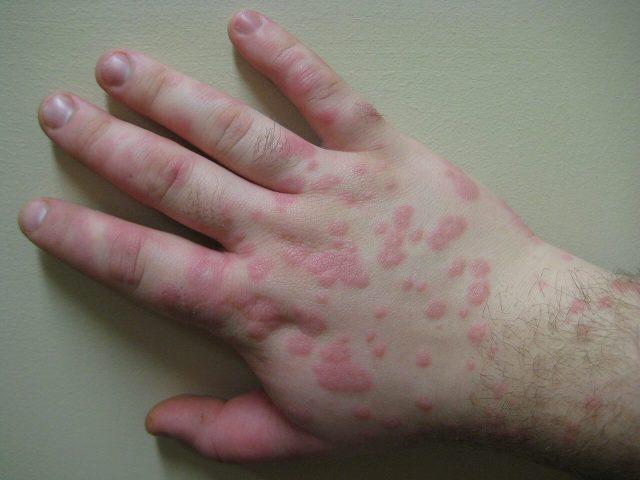Erythema
Erythema is a skin condition caused by increased blood flow that causes redness, swelling, and irritation. It can take various forms, from mild sunburn to painful lumps or rashes, and is often triggered by infections, medications or allergic reactions.
What Is Erythema?
Erythema is a medical term for the skin turning red due to irritation, allergic reaction or increased blood flow to the tiny blood vessels near the skin’s surface. It can happen for many reasons and in many health conditions, including allergic reactions and sunburns. Blushing is a temporary type of erythema. According to Mount Sinai, the cause of erythema can be unknown in about 50% of cases.
- Arthritis
- Fatigue
- Fever
- Flu-like symptoms
- Itching
- Joint pain
- Rash on face and arms, lasting about two weeks
- Sudden spots, bumps and lesions
- Sun exposure
Symptoms vary depending on the underlying cause and the type of erythema.
Types of Erythema
There are several types of erythema, but the three most common are erythema multiforme, erythema nodosum and sun-induced erythema.

Photo Credit: James Heilman, MD
- Erythema multiforme
- Erythema multiforme (EM) is a skin reaction caused by infections, viruses or medications. It appears as red, target-like marks on the skin, often on the fingers and toes. Stevens-Johnson Syndrome, also known as erythema multiforme major, is a more severe case of this health condition. Although symptoms can return, they are likely to resolve in two to four weeks with medication.
- Erythema nodosum
- Erythema nodosum (EN) typically appears as painful, red lumps on the shins. EN can be linked to infections and diseases like tuberculosis or Crohn's. According to Johns Hopkins Medicine, this erythema can also be tied to certain sulfa or penicillin antibiotics. Symptoms may include fever, joint pain and swollen lymph nodes in the chest.
- Sun-induced erythema
- Most commonly known as sunburn, the third and most prevalent type is UV-induced erythema. The most notable symptoms are skin irritation, redness and inflammation caused by exposure to ultraviolet radiation.
Topical Medications for Erythema
Topical treatments for erythema target redness, inflammation and bacteria. They may also try to slow skin growth. Some medications may reduce redness by constricting blood vessels, minimizing inflammation and retaining skin moisture.
Topical medications vary depending on the type of erythema and its underlying causes, such as infection, allergic reactions, sunburn, drug reactions or autoimmune conditions.
- Anthralin
- Drithocreme (dithranol) and Zithranol (anthralin) are topical prescription creams or shampoos that slow the growth of skin cells. They are often used to treat psoriasis and can also be used with corticosteroids (glucocorticoids), known as steroids, to help reduce redness and swelling from erythema. Side effects of anthralin can include allergic reactions, soreness where the cream is applied, severe skin irritation and spreading lesions. If they occur, try applying petroleum to the affected areas.
- Antibiotic creams
- Antibiotic creams like Neo-Fradin (neomycin), Polymyxin B and E (polymyxin), bacitracin and hydrocortisone combination help treat erythema-related skin infections caused by certain bacteria. They can help with redness, swelling, itching and discomfort from bacterial erythema. Side effects of the topical cream can include skin thinning, stretch marks or acne. The more severe side effects can induce burning, further redness or skin irritation. Contact a physician if they occur.
- Calcineurin inhibitors
- Topical calcineurin inhibitors (TCIs) reduce erythema by blocking the protein calcineurin, which triggers skin inflammation. Elidel (pimecrolimus) and Protopic (tacrolimus) are two FDA-approved, short-term therapies for adults that help manage and prevent flare-ups by dampening the immune response and reducing itching and redness. Elidel is for mild-to-moderate symptoms, and Protopic is for moderate-to-severe symptoms. Side effects may include itching and burning at the application site, local skin irritation, and allergic contact dermatitis. They are not advisable for those under the age of two.
- Corticosteroids
- Corticosteroids like Medrol and Cortisone help reduce redness and swelling by calming down the body's natural reactions to irritation. They can help with conditions like erythema multiforme. They come in seven potency levels, from over-the-counter hydrocortisone creams to powerful prescription gels, creams and ointments. Among the side effects of corticosteroids are redness or changes to skin color, itching, burning, stinging or peeling of the skin. Consider seeking a physician’s advice if additional side effects occur, such as open sores, oozing, and erythema flare-ups.
Oral Medications for Erythema
Medical providers typically prefer to prescribe oral treatments for severe erythema cases or when symptomatic relief is needed. Oral antihistamines and analgesics can help manage discomfort, especially when topical treatments are insufficient or impractical. The proper oral medications can help treat the root causes of erythema in cases involving infections.
- Antihistamines
- Antihistamines like Benadryl (diphenhydramine), Claritin (loratadine) or Zyrtec (cetirizine) can help relieve allergic reactions like itching and redness associated with erythema. However, these medications can also cause side effects like drowsiness, dry mouth, dizziness, blurred vision, headaches and gastrointestinal issues. Allegra is a non-drowsy alternative. Consult a healthcare provider to weigh the benefits against the risks of antihistamines.
- Anti-inflammatory drugs (NSAIDs)
- Advil (ibuprofen), Aleve (naproxen sodium), and aspirin block the production of the hormone-like chemicals that cause inflammation, reducing swelling, hives, and pain. Common NSAID side effects include gastrointestinal issues like gas, heartburn, bloating and stomach pain. Generally, those who have pre-existing gastrointestinal concerns like bleeding or ulcers should avoid NSAID drugs. Further side effects include dizziness, lightheadedness and mild headaches. Talk to a doctor if symptoms or side effects persist.
- Immunosuppressants
- Several immunosuppressants — including Humira (adalimumab), Gengraf (cyclosporine) and Thalomid (thalidomide) — may be prescribed if your erythema is an autoimmune reaction. They work by “dialing down” your immune system and easing inflammation. Immunosuppressant side effects include increased risk of blood, skin, respiratory, and fungal infection. They may also cause diabetes, high blood pressure and osteoporosis, among other serious side effects.
Drugs That May Cause or Exacerbate Erythema
Certain medications can cause erythema through hypersensitivity reactions, accounting for less than 10% of all cases. Common culprits include oral contraceptives, antibiotics like sulfonamides, proton inhibitors and leukotriene modifiers. Discuss with a doctor before discontinuing any prescription.
- Antibiotics
- Certain antibiotics like Amoxil (amoxicillin)) can worsen erythema nodosum (EN). These antibiotics can cause allergic reactions that lead to inflammation in the body, most often in children. With EN, a doctor may advise stopping these antibiotics to prevent the condition from worsening.
- Chemotherapy drugs
- Targeted therapy or Chemotherapy drugs such as Taxotere (docetaxel), used to treat breast cancer, can cause skin redness or rashes. Unlike allergic reactions that happen quickly, chemotherapy-induced redness develops more slowly, often days or weeks after an infusion. Although it does not cause severe symptoms like hives or trouble breathing, Taxotere can lead to low white and red blood cell counts.
- Hormonal contraceptives
- Hormonal contraceptives can cause both EN and EM. With EN, some individuals benefit from switching hormonal types. EM, though rarer, has been linked to contraceptive use, particularly in adolescents presenting with oral lesions.
- Leukotriene modifiers
- Leukotriene modifiers are a class of medications that help prevent and treat breathing problems and issues caused by asthma, allergies and chronic obstructive pulmonary disease (COPD). Case reports indicate they may cause or worsen erythema through hypersensitivity reactions.
- Nonsteroidal anti-inflammatory drugs (NSAIDs)
- Nonsteroidal anti-inflammatory drugs (NSAIDs), like ibuprofen, naproxen, and aspirin, are often used to treat erythema. However, they can sometimes trigger erythema multiforme (EN). These reactions may occur due to an allergic response to the medication. NSAIDs can cause skin redness, rashes, or even blisters in sensitive individuals. While cases are rare, stopping the drug immediately and seeking medical attention is crucial if skin issues arise.
- Proton Pump Inhibitors (PPIs)
- Proton pump inhibitors, such as Prilosec (omeprazole), Nexium (esomeprazole), and Prevacid (lansoprazole), treat acid reflux and ulcers. However, they can sometimes cause rare skin conditions like EN or discoloration similar to erythema dyschromicum perstans (EDP). Stopping the medication may improve the adverse side effects. Researchers are still trying to understand this phenomenon.
Lifestyle Tips to Manage and Prevent Erythema
Preventing erythema often requires simple lifestyle adjustments that protect and support the skin. Cooling techniques, a balanced diet, stress management, sun protection and gentle skincare are vital strategies to minimize flare-ups.
- Cooling techniques
- Cold compresses, cold air, or soothing lotions like aloe vera can provide temporary relief. Ice packs can help reduce swelling and pain. They are recommended for laser surgery-induced erythema. It may help to put ice packs on the neck and cheeks, but they should be wrapped in a soft cloth first. Applying ice packs for 10–15 minutes every hour for up to four hours can help.
- Dietary considerations
- Diet can significantly influence erythema development. Strict diets, especially ketogenic diets, and certain food sensitivities can trigger inflammatory skin conditions like prurigo pigmentosa (PP) due to ketone accumulation. For example, a cheese sensitivity can lead to erythema annulare centrifugum (EAC). A balanced diet and avoiding known triggers can help prevent these skin reactions and promote overall skin health.
- Stress management
- Stress can trigger or exacerbate EAC, but symptoms may resolve after a stressful period. Relaxation techniques like mindfulness and yoga may help prevent erythema flare-ups.
- Sun protection
- To prevent sun-induced erythema, avoid sun exposure and wear protective clothing and sunscreen, especially during peak hours. If medications may be the cause, consider adjusting dosages or finding alternatives. Maintaining good hygiene and a nutritious diet supports overall immune health. It can help prevent secondary infections that may worsen erythema symptoms.
- Gentle skincare
- To maintain healthy skin and prevent erythema, use gentle skincare products, including mild cleansers, moisturizers, and daily sunscreen. Avoid harsh products that contain alcohol, fragrance, or menthol. Gradually introducing stronger ingredients like retinoids to monitor and prevent redness may help.
Calling this number connects you with a Drugwatch.com representative. We will direct you to one of our trusted legal partners for a free case review.
Drugwatch.com's trusted legal partners support the organization's mission to keep people safe from dangerous drugs and medical devices. For more information, visit our partners page.

